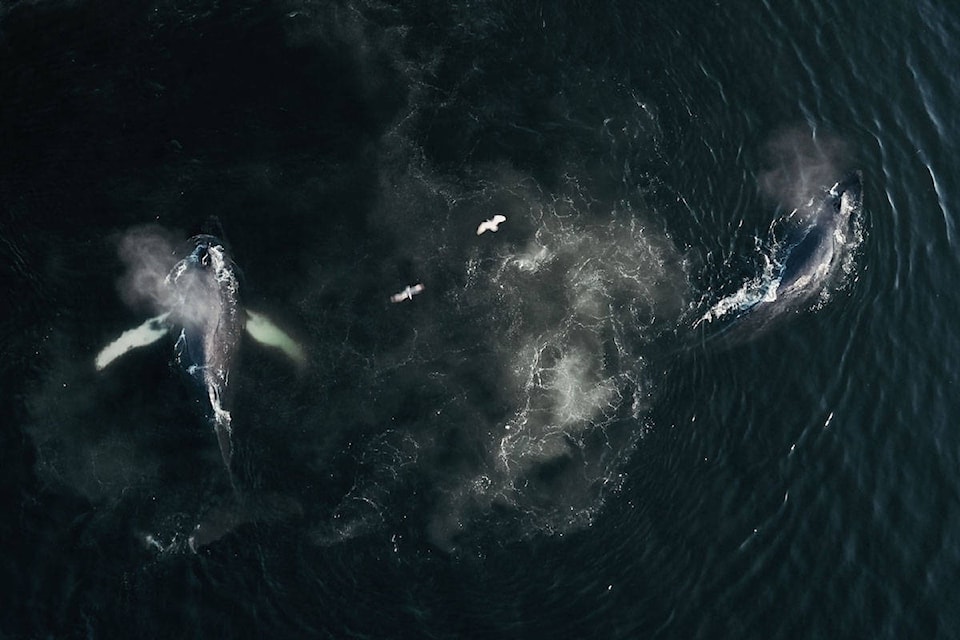A new documentary filmed in Hartley Bay and the surrounding area is gathering international attention, and recently had its North American premiere at the Vancouver International Film Festival.
The Whale and the Raven has already enjoyed success in Germany, where writer and director Mirjam Leuze hails from. It was the opening film of Dok Fest in Munich earlier this year, and in addition to its Vancouver showing has been selected for screening at the International Environmental Film Festival in Toronto later this month.
The film, co-produced by the National Film Board and Cedar Island Films, follows the work of researchers at the Cetacea Lab on Gil Island, approximately 120 km southeast of Prince Rupert and around 80 km southwest of Kitimat.
| Janie Wray on a whale research excursion in the waters off the west coast of Canada. (NFB photo) |
Head researchers Hermann Meuter and Janie Wray founded the lab to learn more about the marine life of the surrounding Kitimat fjord system. The waters are home to a number of whales, including humpback, orca, porpoises and fin whales.
READ MORE: VIDEO AND STORY: Best Boating Practices: How to avoid whales when out on the water
Now, with a new liquefied natural gas (LNG) plant planned for Kitimat, the researchers and filmmakers say the ecosystem will be put at serious risk from the resulting tanker traffic. The film explores these issues from a number of perspectives, including the researchers, members of the Gitga’at Nation and even the whales themselves.
Leuze utilizes a variety of different techniques to portray the story, including a heavy emphasis on the auditory. This is to reflect the heavy dependence of whales on sound to move and hunt in the water. Ship noise has been proven to have a number of adverse effects on these marine mammals by disrupting their ability to hear, meaning the increased tanker traffic stemming from the new LNG plant could be damaging to the Kitimat fjord’s aquatic residents.
| Janie Wray observing humpback whales from land - a unique method of research that is completely unobtrusive. (NFB photo) |
Leuze worked closely with the Gitga’at Nation on the documentary, who are based out of Hartley Bay and on whose territory the Cetacea Lab is located. Leuze said developing this relationship was an intimate and important process.
“We entered into a 16-month-long dialogue with the Gitga’at First Nation to create a protocol that would ensure that the filmmaking process was transparent, respectful and collaborative,” Leuze said. To achieve this, the film and Gitga’at Nation created an advisory committee, established work opportunities for residents and negotiated a footage-sharing agreement.
READ MORE: Anti-LNG pipeline protest in Prince Rupert shows support for Wet’suwet’en
| A member of the Gitga'at First Nation at a spring harvesting camp looking into the quiet and naturally protected waters off the west coast of Canada where humpback whales, pods of orca, fin whales and countless other wildlife species feed, play and raise their young. (NFB photo) |
Leuze also wanted to provide a “voice” to those on who impact will be greatest – the whales themselves. “In order to understand the complexity and diversity of today’s world, I believe we need to tell stories that represent the human point of view as well as the non-human perspective,” she said.
“Under the terminology of ‘post-humanities’ or ‘the Non-human Turn,’ scholars are attempting to reprogram thinking and perception as being the exclusive domain of humans.
| Hermann Meuter looking out across the waters off the southern point of the uninhabited Gil Island in Gitga'at territory. (NFB photo) |
Meuter certainly takes this idea to heart. Along with Wray, the pair have studied whales for decades. They were both adopted into the Ganhada (Raven) and Gispudwada (Blackfish) clans, and have worked with the Gitga’at Nation in attempts to fight the negative effects of oil tankers. They were first introduced to Gil Island as a possible base by Jonny Clifton, former chief of the Gitga’at First Nation, and his wife Helen Clifton, matriarch of the Gispudwada clan.
READ MORE: A new vessel from the Gitga’at First Nation will be sailing into Prince Rupert’s harbour
“It is a community sharing a coast; they arrange themselves, without any aggression or fear of losing out,” Meuter said of the sentient underwater beings.
“These whales, in their conscious social life, they are ahead of us.”
| Cetacea Lab – a whale research station originally built by Janie Wray and Hermann Meuter - at Whale Point on the southern point of the uninhabited Gil Island. (NFB photo) |
Leuze stresses that the point of the film is not to paint anyone in a negative light, highlighting her uncle’s work in a Kitimat aluminum smelter upon arriving in Canada. Rather, she hopes to challenge the idea that humans are above other beings in terms of importance in the world.
“The change from seeing humanity as the ‘pride of creation’ to simply another form of existence within a continuum of living things could fundamentally alter our perception of the world and how we treat it,” Leuze concludes.
Alex Kurial | Journalist
Alex Kurial
Send Alex email
Like the The Northern View on Facebook
Follow us on Twitter
